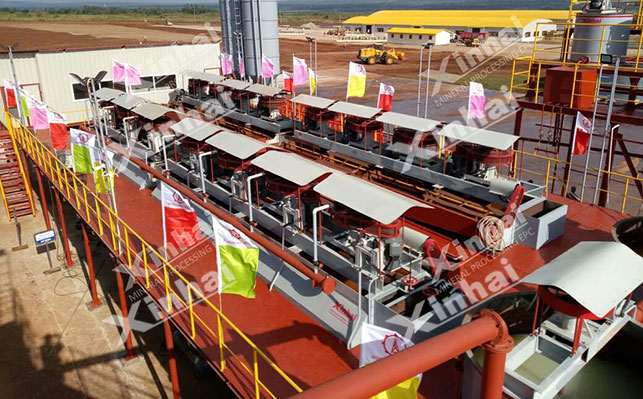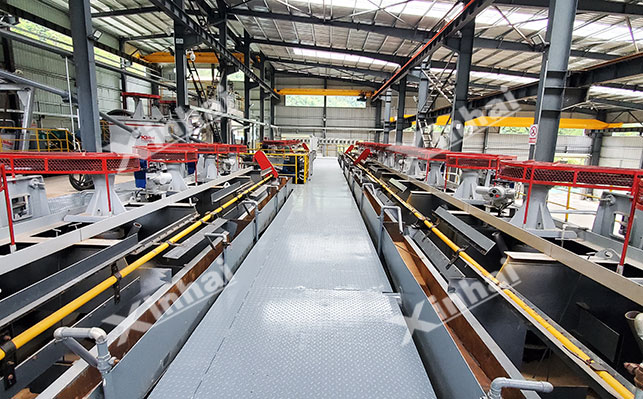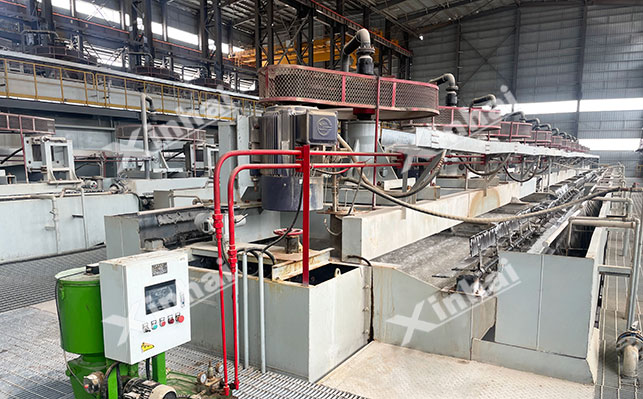
15311826613
Click to add WeChatPhosphate ore is the basic raw material in many fields such as agriculture, chemical industry, and new energy. Its mineral composition is complex and contains many impurities. The main impurities include silicates, carbonates, iron-aluminum oxides, rare earth elements, etc. The phosphorus impurities are different, and the selection methods are also different. Through scientific and reasonable beneficiation technology, effective enrichment of phosphate minerals and removal of impurities are the key links to achieve efficient utilization of phosphate resources. So what are the different phosphate ores beneficiation process flows? Let's learn about it together!
The main impurities of siliceous phosphate ore are silicates. In this type of ore, phosphate minerals and siliceous gangue are closely coexisting, which makes beneficiation more difficult. According to its characteristics, beneficiation plants often use reverse flotation to separate phosphate minerals from gangue. Its process basically follows the process of crushing, grinding, and selection (reverse flotation).

Crushing: The process of coarse crushing-medium crushing or coarse crushing-fine crushing is often used to gradually crush the large pieces of phosphate ore to a suitable particle size, which does not exceed 15mm to create conditions for subsequent grinding operations. To create conditions for subsequent grinding operations.
Grinding: Fine grinding of the crushed minerals to fully dissociate the phosphate minerals from the siliceous gangue. Usually, ball mills, rod mills and other equipment are used, and a spiral classifier or hydrocyclone is used to form a closed-circuit grinding system. During the grinding process, the grinding particle size usually needs to be controlled at -200 mesh (0.074mm) and the content reaches 70-80%.
Reverse flotation: The ore pulp after grinding enters the reverse flotation operation, and inhibitors such as water glass are added. Water glass can selectively adsorb on the surface of phosphate minerals to form a hydrophilic film to inhibit the floating of phosphate minerals; at the same time, amine or modified fatty acid collectors are added. The collectors can react with the surface of silicate gangue to make it hydrophobic. Under stirring and aeration conditions, the hydrophobic silicate gangue adheres to the surface of the bubbles and floats to the surface of the slurry to form a foam layer, while the suppressed phosphate minerals remain in the slurry. In order to further improve the grade of phosphate concentrate, multiple stages of roughing, concentrating and scavenging operations are usually set up, and silicate impurities are removed to the maximum extent through multiple flotation separations.
Dehydration of concentrate: The phosphate concentrate after flotation contains a large amount of water, and it is necessary to dehydrate and filter to reduce the water content for subsequent processing. Generally, a thickener is used for concentration to increase the concentrate concentration from 20%-30% to 50%-60%; then a filter is used to further reduce the moisture content of the concentrate, so that the moisture content of the final product is reduced to below 12%, and a phosphate product that meets the quality requirements is obtained.
The main impurities of calcium phosphate are carbonate minerals, such as calcite, dolomite, etc. For this type of phosphate ore, positive flotation or roasting-digestion process is usually used for beneficiation and impurity removal.

Positive flotation: During the positive flotation process, sodium carbonate is added to the pulp as an adjusting agent to adjust the pH value of the pulp to 8-10, creating a suitable alkaline environment for the action of the agent; at the same time, fatty acid (oleic acid, sodium oleate) collectors are added, which can react chemically with the metal ions on the surface of the phosphate mineral to form a hydrophobic film, so that the phosphate mineral adheres to the bubbles to float. After the roughing, concentrating and scavenging processes, the phosphate concentrate is enriched, and then the final phosphate concentrate product is obtained through concentration and filtration.
Roasting-digestion process: The crushed product is directly roasted at high temperature (800-1000℃). During the process, carbonate impurities undergo decomposition reactions, calcium carbonate decomposes into calcium oxide and carbon dioxide, and magnesium carbonate decomposes into magnesium oxide and carbon dioxide. After the roasted ore is cooled, it is digested with water or dilute acid to dissolve the alkaline oxides such as calcium oxide and magnesium oxide produced by the decomposition into the solution, and then the impurities are removed through water washing, filtration and other processes. Finally, the filter cake is dried to obtain the phosphate product.
Mixed phosphate ore contains multiple impurities such as carbonates and silicates. The ore properties are complex, and a single beneficiation method is difficult to achieve the ideal separation effect. Therefore, the stage grinding-classification-combined flotation process is usually adopted.

Stage grinding and classification: generally divided into two or three stages of grinding, one stage of grinding grinds the ore to a certain particle size, so that some phosphate minerals are initially dissociated from the gangue; then the pulp of qualified particle size is separated by the classification equipment, and the coarse particles are returned for re-grinding. Through stage grinding, the phenomenon of over-crushing caused by one-time grinding is avoided, the loss of fine phosphate minerals is reduced, and the grinding efficiency is improved.
Combined flotation: According to the content ratio and properties of carbonate and silicate impurities in the ore, direct flotation or double reverse flotation can be used to initially remove carbonate impurities. After removing carbonate, the grade of phosphate ore is gradually improved through multi-stage grinding and multiple flotation operations, and various impurities are effectively removed.
The above is an introduction to several different phosphate ore dressing process flows. In actual beneficiation plants, different types of phosphate ores, such as siliceous phosphate ore, calcareous phosphate ore and mixed phosphate ore, require targeted beneficiation process flows due to differences in impurity types, mineral composition, distribution characteristics and grade. At the same time, it is also necessary to comprehensively consider production costs, environmental protection requirements, equipment selection and other factors, and through continuous experimental research and process optimization, develop an economical, efficient, green and environmentally friendly phosphate ore dressing process flow, so as to achieve efficient utilization and sustainable development of phosphate resources.